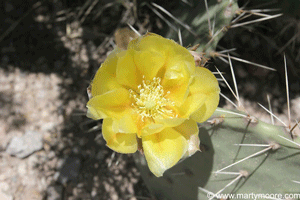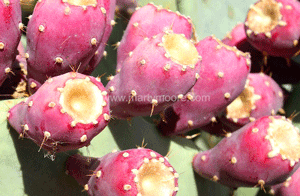Prickly Pear, Optunia. There are several different varieties of prickly pear cacti that do very well in the desert Southwest.
Some have spines, while others are spineless or semi-spineless. Colors vary from yellow, orange, pink and
shades inbetween. Heights and sizes vary also.
Fruits and pads are edible in most prickly pear, the fruit is sold in stores as 'tuna' and the pads are 'nopalitos'.
The fruit is usually eaten raw or made into jellies, while the pads are grilled to burn off the spines.
Prickly Pear can get infested with a white cotton-like substance all over the pads, these are mealy bugs, spray with a systemic insecticide meant for cacti.
Engelmann's Prickly Pear cacti may contract 'Phyllosticta pad spot', a fungus that causes black lesions on the pads. Severely infected pads or entire plants should be taken out to prevent the spread of the fungus.
There is another disease called 'Opuntia Sammon's virus' that attacts Prickly Pear cacti. It causes yellowish rings or mosaic-like patterns in the pads, often called ringspot virus. The virus does not seem to hurt the plant and there are no known control methods.
The Prickly Pear cactus is a great addition to the desert Southwest garden, just watch out for those spines. If you should ever need to remove a large cactus with tons of spines, like the 'Cinnamon" Prickly Pear cactus, make sure you don't stand down-wind when doing so, the tiny spines become airborne and you will have stickers all over you.
Back to list of Shrubs


